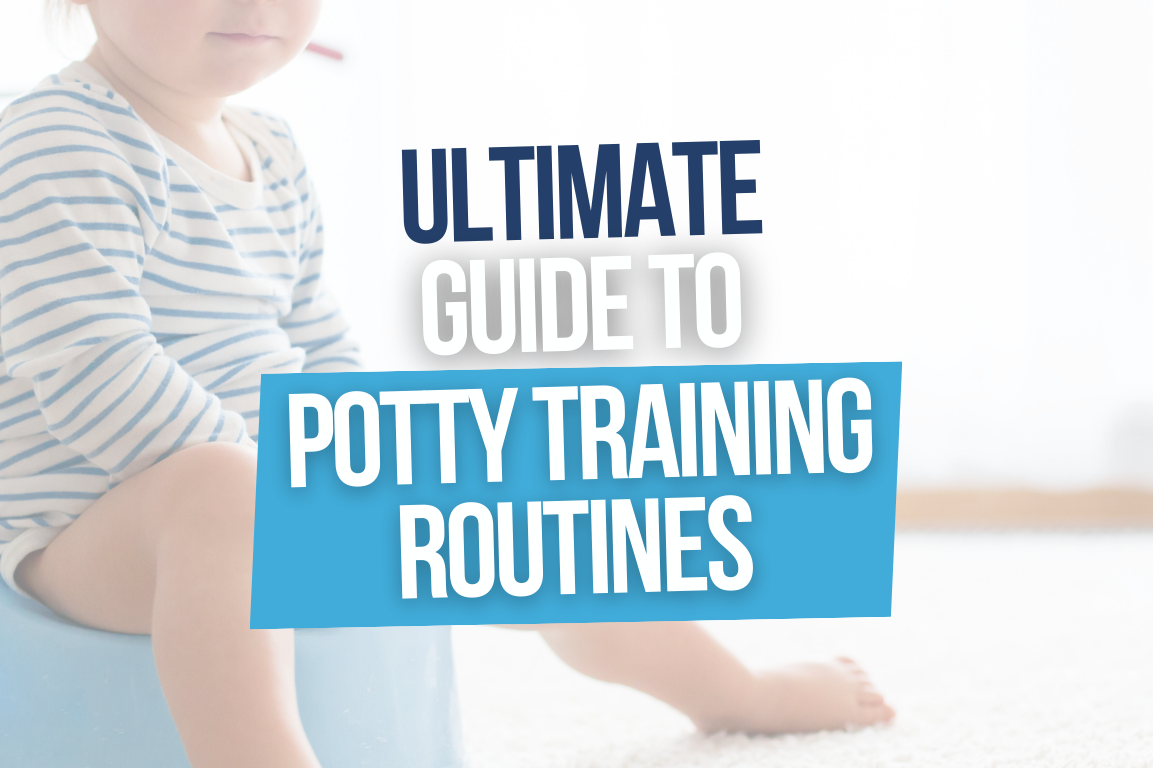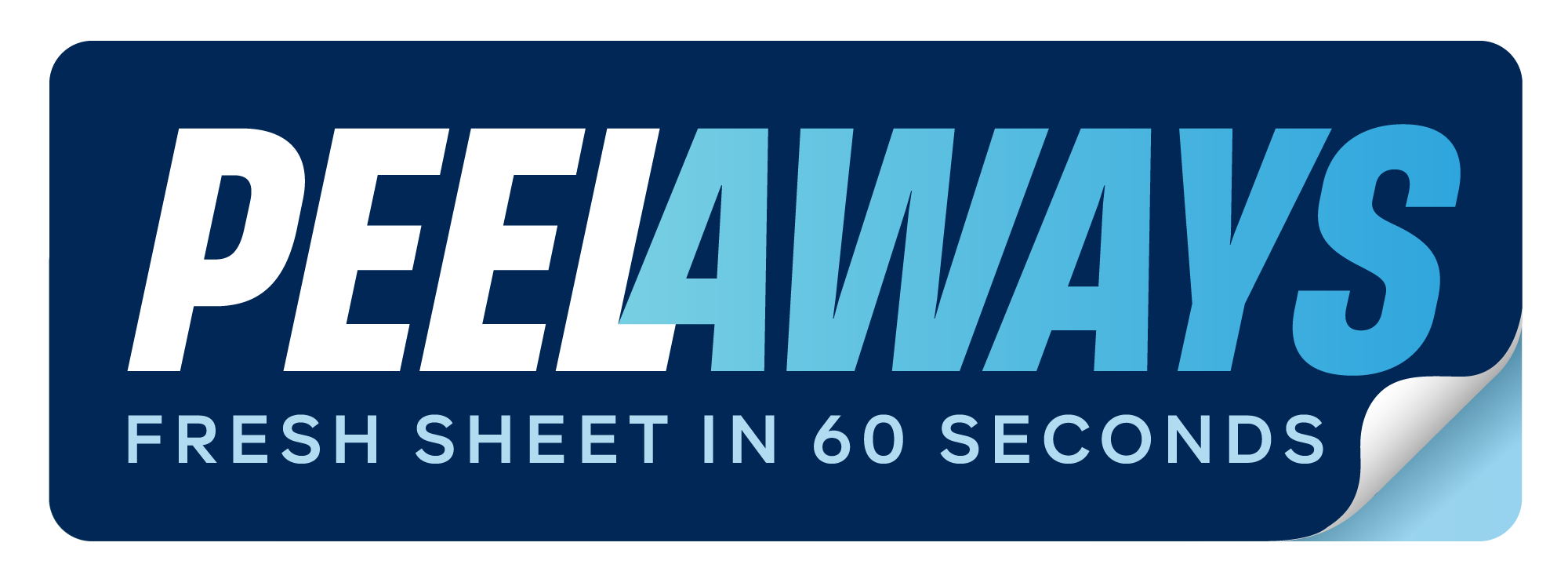Ultimate Guide To Potty Training Routines

Potty training doesn’t have to be overwhelming. The key? Consistency, timing, and preparation. Here's what you need to know:
- Signs of Readiness: Look for physical signs like staying dry for 2–3 hours, waking up dry from naps, and being able to pull down pants. Behavioral signs include following instructions, showing interest in the bathroom, and discomfort with dirty diapers.
- When to Start: Most kids are ready between 18–36 months. Avoid starting during big life changes like moving or welcoming a new sibling.
- Daily Routine: Create a schedule with regular potty breaks (e.g., after waking up, meals, and playtime). Gradually increase intervals as your child progresses.
- Accidents: They’re normal! Stay calm, involve your child in cleanup, and adjust potty breaks based on patterns.
- Supplies: Essential tools include a potty chair or toilet insert, training pants, mattress protectors (like PeelAways sheets), and a reward system (e.g., sticker charts).
- Support: Books like Potty by Leslie Patricelli or Oh Crap! Potty Training can help. Pediatricians or therapists can provide guidance if challenges arise.
Potty training takes patience, but with the right approach and tools, your child will achieve this milestone. Let’s dive into the details!
Making a Potty Training Schedule | Potty Training Expert
How to Know When Your Child is Ready
Timing is everything when it comes to potty training. Start too early, and it can lead to frustration for both you and your child. Wait too long, and you might face unnecessary challenges. Recognizing the signs that your child is ready can make the whole process much smoother.
Physical Signs Your Child is Ready
Your child's physical development plays a big role in determining readiness. For starters, staying dry for 2–3 hours or more is a good indicator that their bladder muscles are strong enough to hold urine. This is a key milestone in potty training.
Another sign is walking steadily and being able to climb onto a potty chair independently. They’ll also need the fine motor skills to pull down their pants, so watch for progress in these areas.
Pay attention to whether your child is aware of their bodily functions. For example, they might tell you when they’re wet or soiled, or you might notice them going to a quiet spot when they need to have a bowel movement. Some children even wake up from naps with a dry diaper, which shows improved bladder control during sleep.
Lastly, regular and predictable bowel movements are a helpful sign. If your child tends to go at the same time each day, it’s easier to establish a routine and anticipate potty breaks.
Physical readiness is just one piece of the puzzle - behavioral signs are equally important.
Behavioral Signs to Watch For
Behavior and emotional development are just as crucial as physical readiness. If your child shows interest in the bathroom, like following you in, asking questions, or watching what you do, it’s a good sign they’re curious and ready to learn.
Another key factor is their ability to follow simple instructions. Potty training involves steps like sitting on the potty and washing hands, so your child should be able to handle basic two-step directions, such as "pick up your toy and put it in the box."
Look for signs of independence and pride in their accomplishments. Children who are ready often want to do things on their own and feel proud when they succeed. You might also notice that they’re uncomfortable with dirty diapers, asking to be changed right away, or even trying to take them off themselves.
Finally, verbal communication can make potty training much easier. Your child doesn’t need to speak perfectly, but they should be able to express basic needs and understand simple words like "pee", "poop", or "potty."
When you see a combination of these physical and behavioral signs, it’s time to think about starting potty training.
What Age to Start Potty Training
Most children are ready for potty training between 18 and 36 months, but every child develops at their own pace. Some may be ready as early as 15 months, while others might not show signs until closer to 3 years old.
Avoid comparing your child to others. Just because your friend’s child was trained at 20 months doesn’t mean your 2.5-year-old is behind. Pushing your child before they’re ready can actually slow down the process.
It’s also important to avoid starting during major life changes like moving, welcoming a new sibling, or transitioning to daycare. Choose a time when you can be consistent and patient, as this will set the stage for success.
While summer might seem convenient for cleanup, the season shouldn’t dictate your timeline. If your child shows signs of readiness in the middle of winter, don’t wait. Readiness is about their development, not the calendar.
The bottom line? Age is less important than observing a mix of physical, behavioral, and emotional signs. When these indicators align, you’ll know it’s time to start gearing up for potty training.
Getting Ready for Potty Training
Once you've recognized the signs that your child is ready for potty training, it's time to set the stage for success. Preparing your environment and gathering the right tools can make the process smoother and less stressful for everyone involved. Here's how to introduce the potty concept and get equipped for this important milestone.
How to Introduce the Potty Concept
Ease your child into the idea of potty training by introducing the concept gradually, well before you dive into the actual process.
Read potty-themed books together. Choose engaging stories that show characters using the potty. Incorporating these books into your bedtime routine can help familiarize your child with the language and steps involved in potty training.
Let your child observe bathroom habits at home. When you or other family members use the bathroom, explain what’s happening in simple terms. For example, say, “Mommy is going pee-pee in the potty,” or “Daddy flushes after he’s done.” This helps normalize the process and shows that using the potty is part of everyday life.
Use toys or dolls to demonstrate potty behavior. Pretend a favorite stuffed animal or doll needs to use the potty, and walk through the steps with them. This playful approach makes the concept less intimidating and more relatable for toddlers, who often learn best through play.
Keep the conversation positive. Talk about potty time in an upbeat way, avoiding negative language like “dirty” or “yucky” when discussing bodily functions. Instead, use neutral terms and celebrate any interest your child shows in the potty. A positive attitude can go a long way in building their confidence.
Once your child starts to grasp the concept, it’s time to gather the tools that will support their potty training journey.
Supplies You Need for Potty Training
Having the right supplies on hand can make potty training more manageable for both you and your child. Here are the essentials:
- A potty chair or toilet insert: Some kids prefer a small potty chair they can use independently, while others might want to use the "big" toilet like grown-ups. If you choose a toilet insert, be sure to get a sturdy step stool so they can climb up safely and rest their feet while sitting.
- Training pants: These are a great transition between diapers and underwear. Look for pairs that are easy to pull up and down, and stock up - 6 to 8 pairs should be enough to avoid constant laundry during the learning phase.
- Mattress and furniture protection: Accidents are inevitable, especially during nighttime training. Products like PeelAways disposable bed sheets are perfect for this stage. They feature multiple layers, so when an accident happens, you simply peel off the top layer to reveal a fresh sheet underneath - no late-night laundry required.
- Flushable wipes: These make cleanup easier for small hands and help your child feel clean and fresh after using the potty. Regular toilet paper can be tricky for toddlers to manage effectively.
- A reward system: Motivation is key during potty training. Consider using a sticker chart, small treats, or special underwear featuring your child’s favorite characters. Immediate rewards can encourage your child to stay engaged and excited about their progress.
With these tools in place, you’ll be ready to handle the inevitable accidents and keep the process moving forward.
How to Protect Beds and Furniture
Accidents are part of the potty training journey, so protecting your child’s sleeping area and other furniture is essential for maintaining peace of mind.
PeelAways disposable sheets are specifically designed for situations like potty training. These sheets come in layers - when an accident happens, you simply peel away the soiled layer to reveal a clean one underneath. For toddlers, the Crib-A-Peel option costs $30.99 and includes five layers, while the Twin size version is available for $34.99 with the same multi-layer design. This system minimizes disruptions during the night and eliminates the need for emergency sheet changes.
Don’t forget other furniture. Waterproof covers for chairs, couches, and car seats can save you from costly cleaning bills. Look for covers that are easy to wipe down or machine washable for added convenience.
Keep cleaning supplies within reach. A small basket with paper towels, disinfectant wipes, and a change of clothes can turn accidents into minor hiccups instead of major stressors. In fact, many children enjoy the idea of “peeling away” a wet layer, which can help reduce anxiety about accidents. When they see that accidents are normal and easy to manage, they’re less likely to feel embarrassed or resist using the potty.
It’s important to remember that accidents may continue for weeks or even months after daytime training is complete. Nighttime dryness often takes longer because it involves changes in sleep patterns. Having reliable protection in place allows you to focus on providing encouragement and consistency, rather than worrying about cleanup or damage. This approach reinforces the routines and positive mindset you’ve worked hard to establish.
Creating Your Daily Potty Training Routine
With your supplies ready and protective measures in place, the next step is to establish a daily routine that helps your child succeed. A consistent schedule not only creates structure but also teaches your child when to anticipate potty breaks, making the process smoother for everyone.
Daily Potty Schedule That Works
The backbone of potty training is a predictable schedule with regular potty times. To start, dedicate a few days exclusively to potty training. This focused approach allows you to maintain consistency without distractions like errands or appointments.
Begin by setting a timer every 20–30 minutes to encourage your child to use the potty before accidents occur. Plan these breaks around natural transitions in their day - such as when they wake up, after meals or snacks, after playtime, before bath time, and right before bed. These moments align with your child’s natural rhythms, making potty breaks feel like a regular part of their routine.
As your child starts to succeed, gradually extend the time between breaks. For example, after two days of consistent success, increase the intervals by 5 minutes until you reach a 45-minute to 1-hour schedule[2]. During each potty visit, have your child sit for 3–5 minutes. Keep the atmosphere calm and relaxed to make the experience positive.
This consistent approach not only helps build a habit but also reinforces their progress.
How to Reward and Encourage Your Child
Positive reinforcement plays a big role in potty training success. Immediate rewards like verbal praise and affection often work better than material incentives. A simple high-five, a hug, or an enthusiastic comment like, “Great job! You’re using the potty like a big kid!” can make a huge impact.
Sticker charts are another fun and effective tool. Create a chart where your child can add a sticker for each successful potty visit. Once they collect a certain number of stickers - say, 5 or 10 - they can earn a small reward, like extra story time or a little toy.
When accidents happen (and they will), stay calm. A gentle reminder like, “Accidents happen. Let’s clean up and try again,” keeps the focus on learning rather than discouragement.
Keeping Track of Progress
Tracking your child’s progress helps you maintain consistency and adjust your approach as needed. A simple log or sticker chart can be used to record potty visits and identify patterns. This not only helps you fine-tune the schedule but also gives your child a sense of achievement.
Pay close attention to when accidents are more likely to occur, such as 15–20 minutes after meals, during exciting play, or when transitioning between activities. Recognizing these patterns allows you to plan extra potty breaks during high-risk times.
Nighttime training often takes longer than daytime training, so it’s helpful to track these separately. While many children take about three months to become fully potty trained, some intensive methods suggest success in as little as 3–7 days with full parental focus[1]. Keep in mind that girls often pick up potty training slightly faster than boys, and consistent parental involvement is key. Your tracking efforts will not only help you celebrate milestones but also keep you motivated through the ups and downs of the process.
sbb-itb-45288fe
Solving Common Potty Training Problems
Potty training can be a bumpy road, even with a solid plan in place. Every child is unique, and what works like a charm for one may not work at all for another. The trick is to stay patient, adapt to your child’s needs, and have practical strategies ready for when issues arise.
What to Do About Resistance and Accidents
Resistance is a common challenge many parents face. Your child might refuse to sit on the potty, cry during potty time, or insist on sticking with diapers. This is completely normal and often comes from fear of change, a need for control, or simply not being ready yet.
Instead of forcing the issue, try to make the process more appealing. Let your child choose fun underwear or create a potty-time ritual like singing a song or playing a short game while they sit for a few minutes. If resistance lasts more than a week, consider taking a break for a couple of weeks before trying again. This doesn’t mean you’ve failed - it just means your child might need a bit more time to adjust.
Accidents are part of the learning process, so expect them to happen. Many children continue to have accidents for weeks or even months after starting potty training. What’s important is how you respond. Stay calm and avoid showing frustration. A simple, “Oops, let’s clean up and try again,” works wonders in keeping your child’s confidence intact.
Involve your child in cleaning up, like tossing wet clothes into the laundry. This helps them understand consequences without feeling ashamed. Also, watch for patterns. If accidents happen consistently 20 minutes after drinking, adjust potty breaks accordingly. If they occur during exciting activities, schedule extra potty trips before playtime.
Handling Setbacks and Special Needs
Regression can be especially frustrating when it feels like progress is slipping away. A child who’s been doing well might suddenly have frequent accidents or refuse to use the potty. This often happens due to stress from changes like starting daycare, family transitions, or the arrival of a new sibling.
During these times, go back to basics. Increase potty reminders, celebrate small wins, and ease up on expectations. Regression phases are usually temporary, lasting a week or two when approached with patience and consistency.
For children with special needs, potty training may take more time and require tailored strategies. Kids on the autism spectrum often benefit from visual schedules or social stories that explain the process. Children with physical disabilities might need adaptive equipment or alternative techniques for sitting comfortably.
If your child has developmental delays, potty training doesn’t have to wait, but the timeline may need adjustment. Work with your healthcare team to create a plan that suits your child’s needs. In some cases, a slow and gradual introduction to the potty over months works better than intensive training.
Medical issues like constipation, urinary tract infections, or sensory challenges can also play a role. If your child seems uncomfortable, has frequent accidents despite showing readiness, or resists strongly, consult your pediatrician for guidance.
Keeping the environment clean and stress-free is an important part of these strategies, making the process smoother for both you and your child.
Keeping Things Clean During Training
The mess that comes with potty training can feel overwhelming, especially when nighttime accidents are involved. Bladder control during sleep often takes longer to develop, so it’s common for kids to have occasional nighttime accidents even after mastering daytime potty use.
Traditional cleanup methods can be exhausting. Changing sheets in the middle of the night means stripping the bed, washing everything, and remaking it - all while dealing with a sleepy, possibly upset child.
Simplifying cleanup can make a big difference. PeelAways offers a practical solution with their disposable, waterproof fitted sheets. These sheets have multiple layers you can peel off after an accident, leaving a clean, dry layer underneath. No lifting mattresses, no late-night laundry, and no lingering odors.
This quick solution not only saves time but also helps you stay calm during accidents, which reassures your child and reduces their stress. PeelAways also protect furniture during daytime training. Use them on couches, chairs, or car seats to prevent messes while your child is still learning to recognize the urge to go. The soft, breathable material feels comfortable against the skin while keeping everything underneath dry.
With tools like this, you can focus less on cleanup and more on supporting your child through the potty training journey.
Best Products and Resources for Potty Training
Having the right tools and resources can make potty training smoother and less stressful. To complement the strategies and supplies mentioned earlier, here are some essential products and resources to consider for your potty training routine.
Must-Have Potty Training Products
Potty chairs and toilet seats are key items for potty training success. A standalone potty chair gives toddlers a sense of independence since they can use it on their own. Look for features like removable bowls for easy cleaning and non-slip bases for added safety.
For kids eager to use the "big kid" toilet, toilet seat inserts are a great option. Choose inserts with handles for stability and soft padding for comfort. Pair these with a sturdy step stool to help your child climb up safely and position their feet correctly while sitting.
Training pants are a helpful transition between diapers and regular underwear. Pull-up style training pants let kids practice pulling them up and down on their own, promoting independence. Some parents prefer cloth training pants because they make it easier for kids to feel when they're wet, while others opt for disposable versions for convenience, especially during outings.
Regular underwear can also be a strong motivator. Let your child pick out "big kid" underwear with their favorite characters or colors to make the transition exciting. Stock up on several pairs to avoid extra laundry stress during accidents.
Cleaning and protection supplies are lifesavers during this phase. Keeping your environment clean reinforces consistency in potty training. For nighttime accidents, PeelAways disposable fitted sheets are a practical solution. They protect mattresses with a waterproof barrier while providing a soft, breathable surface for comfort. These sheets can also be used on furniture and car seats during the day to prevent messes while your child is still learning.
Reward and tracking tools keep motivation high. Sticker charts are effective for visual learners who enjoy tracking their progress. Small rewards, like stickers or extra story time, often work better than larger prizes. Keeping a simple notebook or using an app can help you identify patterns in accidents and successes, making it easier to adjust your approach.
Portable potty seats are another must-have for outings. These clip onto public toilets, making them less intimidating for kids. Always keep travel-sized packs of wipes and extra underwear in your diaper bag to handle any surprises during this transition.
Helpful Books and Websites
Educational books can ease the process for both parents and children. Potty by Leslie Patricelli uses simple illustrations and minimal text that toddlers find engaging. This book normalizes potty use and often becomes a favorite read during this period.
Diapers Are Not Forever by Elizabeth Verdick introduces potty training concepts in a gentle, step-by-step way that young children can easily understand. Reading books like these together before starting potty training helps kids know what to expect.
For parents, Oh Crap! Potty Training by Jamie Glowacki offers a straightforward, practical guide. It tackles common concerns, provides realistic timelines, and includes troubleshooting tips for various challenges. Many parents appreciate its honest and relatable tone.
Online resources offer additional support and a sense of community. The American Academy of Pediatrics website provides evidence-based advice on readiness signs and managing common potty training challenges. Their articles can help you distinguish between normal setbacks and situations that may require professional input.
Parenting forums like BabyCenter and What to Expect are also valuable. These platforms have active potty training communities where parents share tips, experiences, and advice. They can be especially helpful for addressing specific situations, such as potty training children with special needs or managing regression.
Professional guidance may be necessary when typical strategies aren’t working. Pediatricians can help rule out medical issues like constipation or urinary tract infections that might interfere with potty training. They can also offer tailored advice based on your child’s health and development.
Occupational therapists are a great resource for children with sensory or physical challenges that impact potty training. They can suggest adaptive equipment or modified techniques that better suit your child’s needs.
Child development specialists can assist with behavioral challenges or developmental delays. They’ll work with you to create a personalized approach that aligns with your child’s learning style and pace.
These products and resources can make your potty training journey more manageable and effective. With the right tools and support, you’ll be better equipped to guide your child through this important milestone.
Final Tips for Potty Training Success
Wrapping up the potty training journey requires a mix of patience, consistency, and preparation. Every child moves at their own pace, so what works for one family might need tweaking for another. The trick is to stick to your routine while staying adaptable.
Celebrate the little wins. Whether it’s your child sitting on the potty for the first time, staying dry for a couple of hours, or using the toilet independently, every step forward deserves recognition. Small rewards like a sticker, extra playtime, or a favorite snack can keep your child motivated. And when accidents happen (because they will), keep it low-key. Treat them as part of the learning process, not a setback.
Get everyone on the same page. If multiple caregivers are involved, consistency is key. Share your potty schedule, reward system, and any specific phrases or techniques that work for your child. A unified approach helps your child feel secure and speeds up the learning process.
Be ready for accidents. Stock up on supplies to make cleanup easier and less stressful. Products like PeelAways disposable fitted sheets can save you from those middle-of-the-night mattress changes. Having these tools handy ensures accidents don’t disrupt your child’s progress - or your sleep.
Adapt when needed. If your child seems overwhelmed or resistant, it’s okay to adjust the routine or even take a short break. Progress isn’t always linear, and setbacks are part of the process. Trust your instincts - if things aren’t clicking, try again in a week or two. Also, keep in mind that nighttime dryness often takes longer than daytime potty training, so don’t rush it.
Lean on your support system. Whether it’s advice from family, tips from online parenting groups, or guidance from your pediatrician, having a network can make this phase feel less isolating. Don’t hesitate to ask for help or encouragement when you need it.
Potty training may feel like a long road, but it’s just a phase - and it will pass. With the right tools, realistic expectations, and plenty of patience, you’ll help your child reach this milestone. Focus on progress, not perfection, and remember - every accident is just another step toward independence.
FAQs
How do I know if my child is going through potty training regression, and how can I help them get back on track?
Potty training regression can occur when a child who was making steady progress suddenly starts having frequent accidents, avoids using the potty, or appears stressed. This is often triggered by things like changes in routine, emotional challenges, or developmental milestones.
The best approach is to stay calm and patient. If needed, take a brief break from training to ease any pressure. Offer lots of encouragement and avoid punishment - it’s important to create a positive and supportive environment. Celebrate even the smallest wins to help rebuild confidence. If the regression continues for more than a month, it’s a good idea to check in with your pediatrician to rule out any medical or emotional issues.
For nighttime accidents, products like Peelaways disposable, waterproof bed sheets can be a lifesaver. These sheets have peel-away layers, so you can quickly remove a soiled layer without the hassle of lifting the mattress or doing extra laundry. It’s a practical way to make cleanup easier and reduce stress during this phase.
How can I help my child if they refuse to use the potty?
If your child is pushing back against potty training, try to make the experience feel relaxed and natural. One way to do this is by giving them some control - let them decide when they’re ready to try. Pair this with positive reinforcement, like handing out stickers or small treats for every successful attempt. You can also read lighthearted, potty-themed books together to help ease any fears and make the process more fun.
Consistency plays a big role here. Set gentle but clear rules around potty use, and stick to a predictable routine. It’s important to stay calm and patient - getting frustrated can often make kids dig their heels in even more. Keep in mind that every child moves at their own speed, so tuning into their emotions and offering steady encouragement can make all the difference. For nighttime training, consider products like Peelaways - waterproof, disposable bed sheets with peel-away layers - to simplify cleanup and reduce stress for both you and your child.
What’s the best way to handle nighttime accidents during potty training?
Nighttime accidents are a common part of potty training, but handling them doesn’t have to be overwhelming. Start by reducing your child’s fluid intake in the evening and making sure they use the bathroom right before bed. You might also try waking them up early in the morning for a quick bathroom trip to prevent accidents.
For easier cleanups, consider waterproof sheets like PeelAways. These sheets have a smart multi-layer design - just peel off the top layer after an accident to reveal a clean, fresh one underneath. No need to deal with laundry or extra hassle. Most importantly, stay patient and use positive reinforcement to boost your child’s confidence throughout this process.
Related posts
- 7 Essential Tips for Nighttime Incontinence Care
- 5 Best Bed Protection Methods for Potty Training
- Quick Guide: Managing Overnight Accidents in Children
- Peelaways vs. Traditional Waterproof Sheets
Comments
0

SAVE MONEY & WATER
Professionals & Institutions save a fortune on labor/laundry.

SUPERIOR COMFORT
The first thing our customers notice is how soft our sheets are.

100% WATERPROOF
Each layer is 100% Waterproof, perfect for spills and accidents

SAVE TIME
Change the sheet in under 1 minute without stripping the bed.




Leave a comment